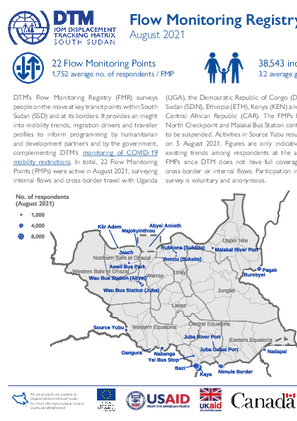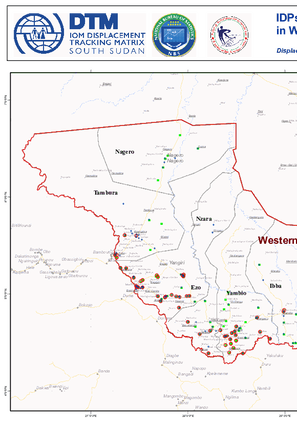-
Countries
-
Data and Analysis
-
Special Focus
-
Crisis Responses

Contact
DTM Djibouti, DTMDjibouti@iom.int
Language
English
Location
Djibouti
Period Covered
Nov 01 2021
Nov 30 2021
Activity
- Survey
- Flow Monitoring Survey
- Flow Monitoring
- Migrants presence
This dashboard presents the main migration trends observed in Djibouti in November 2021. It aims to provide an overview of the main mobility trends in Djibouti, through both quantitative and qualitative analyses, obtained from several data collection tools developed by IOM Djibouti.
This dashboard includes:
- A monthly update on the key data obtained through the Flow Monitoring Registry (FMR) at the 10 active Flow Monitoring Points (FMPs) in Djibouti;
- Key data on spontaneous returns from Yemen and movements observed between Djibouti and Ethiopia;
- Anmonthly update on the profile, vulnerabilities, migratory experience and intentions of the migrants surveyed through the Flow Monitoring Surveys (FMS);
- An update on the presence of migrants stranded in Djibouti.

Contact
DTM Djibouti, DTMDjibouti@iom.int
Language
French
Location
Djibouti
Period Covered
Nov 01 2021
Nov 30 2021
Activity
- Survey
- Flow Monitoring Survey
- Flow Monitoring
- Migrants presence
Ce tableau de bord présente les principales tendances migratoires observées à Djibouti en novembre 2021. Il vise à fournir une vue d'ensemble des principales dynamiques migratoires au niveau de Djibouti, en présentant des analyses à la fois quantitatives et qualitatives obtenues à travers plusieurs outils de collectes de données développées par l'OIM Djibouti.
Ce tableau de bord comprend:
- Une mise à jour mensuelle des principales données obtenues à travers l’enregistrement des flux aux 10 points de suivi des flux (FMP) actifs à Djibouti;
- Des données clés sur les retours spontanés du Yémen ainsi que sur les mouvements entre Djibouti et l'Éthiopie;
- Une mise à jour mensuelle sur les profils, vulnérabilités, parcours migratoires et intentions des personnes interrogées à travers les enquêtes individuelles (FMS);
- Une mise à jour sur la présence des migrants bloqués à Djibouti.
The COVID-19 outbreak has restricted global mobility, whilst heightening the risk of exploitation of vulnerable populations. This report provides a snapshot of the COVID-19 epidemiological situation and mobility restrictions, and of the current migration trends along the Eastern Corridor migration route, in addition to an analysis of the impact that movement restrictions have had in Djibouti, Ethiopia, Somalia, and Yemen. Moreover, it provides information on the main protection concerns for migrants and assistance provided, and COVID-19 risk mitigation measures. This report utilizes data collected through IOM’s Displacement Tracking Matrix (DTM) Flow Monitoring Points (FMPs), Migration Response Centres (MRCs),1 Assisted Voluntary Return (AVR) data, as well as anecdotal information provided by IOM team members working in the region.

Contact
DTM South Sudan, SouthSudanDTM@iom.int
Language
English
Location
South Sudan
Period Covered
Sep 01 2021
Sep 30 2021
Activity
- Flow Monitoring
DTM’s Flow Monitoring Registry (FMR) surveys people on the move at key transit points within South Sudan (SSD) and at its borders. It provides an insight into mobility trends, migration drivers and traveller profiles to inform programming by humanitarian and development partners and by the government, complementing DTM’s monitoring of COVID-19 mobility restrictions. In total, 23 Flow Monitoring Points (FMPs) were active in September 2021, surveying internal flows and cross-border travel with Uganda (UGA), the Democratic Republic of Congo (DRC), Sudan (SDN), Ethiopia (ETH), Kenya (KEN) and the Central African Republic (CAR). The FMPs Renk North Checkpoint and Malakal Bus Station continue to be suspended. Figures are only indicative of existing trends among respondents at the active FMPs since DTM does not have full coverage of cross-border or internal flows. Participation in the survey is voluntary and anonymous.
Please click here to access a summary dataset.
Contact
SouthSudanDTM@iom.int
Location
South Sudan
Activity
- Flow Monitoring Survey
- Flow Monitoring
Period Covered
Sep 01 2021 -Sep 30 2021
Flow monitoring aims to derive quantitative estimates of the flow of individuals through specific locations and to collect information about the profile, intentions and needs of the people moving and to quantify highly mobile populations by providing a picture of complex mobility dynamics.
Population Groups
Survey Methodology
Unit of Analysis Or Observation
Type of Survey or Assessment
Keywords
Geographical Scope
Administrative boundaries with available data
The current dataset covers the following administrative boundaries

Contact
DTM South Sudan, SouthSudanDTM@iom.int
Language
English
Location
South Sudan
Period Covered
Aug 01 2021
Aug 31 2021
Activity
- Flow Monitoring
DTM’s Flow Monitoring Registry (FMR) surveys people on the move at key transit points within South Sudan (SSD) and at its borders. It provides an insight into mobility trends, migration drivers and traveller profiles to inform programming by humanitarian and development partners and by the government, complementing DTM’s monitoring of COVID-19 mobility restrictions. In total, 22 Flow Monitoring Points (FMPs) were active in August 2021, surveying internal flows and cross-border travel with Uganda (UGA), the Democratic Republic of Congo (DRC), Sudan (SDN), Ethiopia (ETH), Kenya (KEN) and the Central African Republic (CAR). The FMPs Renk North Checkpoint and Malakal Bus Station continue to be suspended. Activities in Source Yubu resumed on 5 August 2021. Figures are only indicative of existing trends among respondents at the active FMPs since DTM does not have full coverage of cross-border or internal flows. Participation in the survey is voluntary and anonymous.
Please click here to access a summary dataset.

Contact
DTM South Sudan, SouthSudanDTM@iom.int
Language
English
Location
South Sudan
Period Covered
Jul 01 2021
Jul 31 2021
Activity
- Flow Monitoring
DTM’s Flow Monitoring Registry (FMR) surveys people on the move at key transit points within South Sudan (SSD) and at its borders. It provides an insight into mobility trends, migration drivers and traveller profiles to inform programming by humanitarian and development partners and by the government, complementing DTM’s monitoring of COVID-19 mobility restrictions. In total, 21 Flow Monitoring Points (FMPs) were active in July 2021, surveying internal flows and cross-border travel with Uganda (UGA), the Democratic Republic of Congo (DRC), Sudan (SDN), Ethiopia (ETH), and Kenya (KEN)4. The FMP Renk North Checkpoint continues to be suspended. Since mid-June, data collection activities in Source Yubu are on hold due to insecurity, while activities at Malakal Bus Station are halted due to inaccessibility caused by flooding. Figures are only indicative of existing trends among respondents at the active FMPs since DTM does not have full coverage of cross-border or internal flows. Participation in the survey is voluntary and anonymous.
Please click here to access a summary dataset.

Contact
DTM South Sudan, SouthSudanDTM@iom.int
Language
English
Location
South Sudan
Period Covered
Jun 01 2021
Jun 30 2021
Activity
- Flow Monitoring
DTM’s Flow Monitoring Registry (FMR) surveys people on the move at key transit points within South Sudan (SSD) and at its borders. It provides an insight into mobility trends, migration drivers and traveller profiles to inform programming by humanitarian and development partners and by the government, complementing DTM’s monitoring of COVID-19 mobility restrictions. In total, 23 Flow Monitoring Points (FMPs) were active in June 2021, surveying internal flows and cross-border travel with Uganda (UGA), the Democratic Republic of Congo (DRC), Sudan (SDN), Ethiopia (ETH), Kenya (KEN) and the Central African Republic (CAR). The FMP Renk North Checkpoint continues to be suspended, while data collection activities in Source Yubu were interrupted mid-June due to insecurity. and in Malakal Bus Station due to flooding. Figures are only indicative of existing trends among respondents at the active FMPs since DTM does not have full coverage of cross-border or internal flows. Participation in the survey is voluntary and anonymous.
Please click here to access summary dataset.



